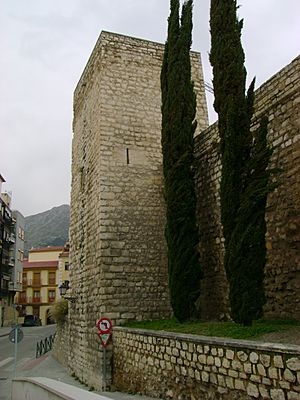Siege of Jaén (1225) facts for kids
Quick facts for kids Siege of Jaén |
|||||||
|---|---|---|---|---|---|---|---|
| Part of the Reconquista | |||||||
 The tower, Torreón del Conde de Torralba. One of the many on the walls of Jaén. |
|||||||
|
|||||||
| Belligerents | |||||||
Taifa of Baeza |
Taifa of Jayyān (جيان) | ||||||
| Commanders and leaders | |||||||
Abd Allah Ibn Muhammad Al-Bayyasi |
Álvaro Pérez de Castro el Castellano | ||||||
| Strength | |||||||
| Combined armies of Castile and Baeza | 3,000 Muslim knights 50,000 infantry 160 Christian knights |
||||||
| Casualties and losses | |||||||
| Unknown | 180 cavalry and 2,000 foot soldiers taken prisoner. | ||||||
The Siege of Jaén in 1225 was a battle for the city of Jaén during the Reconquista. The Reconquista was a long period when Christian kingdoms in Spain tried to take back land from Muslim rule.
In this siege, the armies of the Kingdom of Castile and their ally, the Taifa of Baeza, attacked Jaén. They were led by King Ferdinand III of Castile and Abd Allah Ibn Muhammad Al-Bayyasi from Baeza. The city of Jaén was defended by the Taifa of Jayyān. Their forces were commanded by a famous Christian knight named Álvaro Pérez de Castro.
The battle ended with a victory for Jayyān. The Castilian forces could not capture the city. However, the areas around Jaén were badly damaged during the siege. This siege was part of King Ferdinand III's first military campaign, which lasted from 1224 to 1230. It happened before another important battle, the siege of Andújar, in the same year.
Why Jaén Was Important
Taking control of Jaén was very important for the Kingdom of Castile. It would help them expand their territory into the Baetic Depression, a fertile area in southern Spain.
However, capturing Jaén was difficult because of its strong walls. These walls were built by the Almohad Caliphate. They had already helped Jaén fight off attacks before, like one by Alfonso VII of León and Castile in 1151-1152. Another attack by the Almohads in 1162 also failed because of these defenses.
Knowing this, King Ferdinand III of Castile began his campaign in 1224. He attacked the lands around Jaén, setting up his main camp in Baeza. He was joined by his Muslim ally, Abd Allah Ibn Muhammad Al-Bayyasi, who was the king of the Taifa of Baeza. This first campaign was like a test to see how strong Jaén's defenses really were.
The Siege Begins
A large Castilian army, led by King Ferdinand III of Castile, marched from Toledo. On their way to Jaén, they met up with Ferdinand III's ally, King Abd Allah Ibn Muhammad Al-Bayyasi, and his soldiers from the Taifa of Baeza. Ferdinand III's army approached Jaén to check its defenses and see if they could take the city.
During the siege, the Castilian army set up camps all around Jaén, completely surrounding the city. The soldiers in these camps were ordered to wear down the defenders. They did this by raiding the countryside, taking all its resources, and destroying buildings. This strategy is called a "campaign of attrition."
The main event of the siege happened during one of these raids. The defending troops from Jaén came out to attack the Castilian camps. In response, the Castilians tried to storm the city walls. However, their attack was not successful.
The siege was called off soon after this failed attack. The Castilian army then moved on to Andújar, which they managed to capture later in 1225.
What Happened After
The Castilian forces failed to capture Jaén. They did not have enough siege equipment to keep up a long attack. However, a historical record called the Crónica de Ávila mentions that trebuchets (large war machines) were used in the battle.
The defense of Jaén was led by 160 Christian knights. They fought alongside the Muslim defenders. All these forces were under the command of the Castilian noble, Álvaro Pérez de Castro el Castellano. He was a powerful leader from the House of Castro and a grandson of Alfonso VII of León and Castile.
According to Christian records, about 3,000 Muslim knights and 50,000 foot soldiers defended the city. This was in addition to the 160 Christian knights led by Castro.
See also
 In Spanish: Asedio de Jaén (1225) para niños
In Spanish: Asedio de Jaén (1225) para niños
- Jaén, Spain
- List of Castilian Battles
- Ferdinand III of Castile

